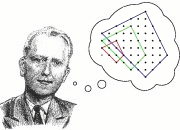 | Research Group Lattice Polytopes |  |
|
|
 | Research Group Lattice Polytopes |  |
|
|



| class date |
Contents |
Notes | last modified |
| 10/14 |
Motivation Types of mathematical optimization convex optimization, linear and integer optimization example of linear optimization in 2D graphical solution weak duality Assigments, linear programming formulation |
||
|
Basics of linear programming standard and canonocal form transformation rules |
|||
| 10/21 |
transformation rules basic (feasible) solutions of systems in standard form |
||
|
Farkas Lemma Definition of cones, affine, linear, convex sets polyehdral, finitely generated cones Fourier-Motzkin-elimination Farkas Lemma Minkowski-Weyl-Duality for cones |
|||
| 10/28 |
Polyhedra and Polytopes polyhedra affine Weyl-Minkowski duality H- and V-description recession coneand lineality space dimension |
||
|
Duality in Linear Programming weak duality theorem |
|||
| 11/04 |
Duality in Linear Programming constructing the dual linear program duality theorem complementary slackness theorem |
||
|
Faces of Polyhedra definitions faces are intersections of hyperplanes geometric interpretation of duality and slack redundancy and facets |
|||
| 11/11 |
facets correspond to irredundant inequalities minimal faces refined affine Minkowski theorem edges and extremal rays minimal proper faces generating sets of cones minimal generating sets of polyhedra characterizations of vertices connection to linear programming |
||
| 11/18 |
minimal proper faces extremal rays of cones description of polyhedra as convex hull and cone minimality and uniqueness of interior description characterization of pointedness optimal solutions of linear programs are vertices |
||
|
Matching Polytopes graphs, matchings, perfect matchings characteristic vectors definition of the (perfect) matching polytope as convecx hull exterior description of the (perfect) matching polytope for bipartite graphs |
|||
| 11/25 |
characterization ofperfect matching polytopes of
general graphs (Edmonds) characterization of the matching polytope |
||
| 12/02 |
Complexity and Sizes of Rational Polyhedra binary encoding of numbers algorithms decision and optimization problems running time fuctions P, NP, coNP, well-characterized problems sizes of solutions of systems of linear equations and inequalities bound on the size of interior in the exterior description, and vice versa linear programming is well-characterized |
||
| 12/09 |
The Simplex Method I primal simplex method: phase II simplex tableau |
||
| 12/16 |
The Simplex Method II simplex method: phase I cycling row and column selection rules dual simplex method |
||
| 12/22 | Christmas Break | ||
| 01/06 |
dual simplex method continued reduced tableaus primal-dual methods sensitivity |
||
|
Integer Polyhedra definitions integer hull of a polyhedron |
|||
| 01/13 |
integer hull is a polyhedron characterizations Hilbert bases |
||
|
Unimodularity definitions characterizations polyhedra defined by unimodular matrices |
|||
| 01/20 |
more on unimodular matrices Theorem of Ghouila-Houri |
||
|
Applications of Unimodularity undirected graphs matchings and vertex covers König's Theorem weighted versions |
|||
| 01/27 |
directed graphs MaxFlow-MinCut-Theorem algorithm of Ford-Fulkerson |
||
|
Total Dual Integrality unimodular transformations Hermite normal form lattice preserving transformations Integral alternative theorem |
|||
| 02/03 |
totally dual integrable systems TDI and integral polyhedra faces of TDI systems are TDI Hilbert bases of normal cones minimally TDI systems |
||
|
Chvatal-Gomory Cuts elementary closures cutting planes elementary closure of TDI systems |
|||
| 03/10 |
computing integer hulls bounds on the Chvatal rank |
||
| 10/15 | Graphs | ||
| References |
| Sheet 1 | deadline: 08/10/21 | |
| Sheet 2 | deadline: 08/10/28 | |
| Sheet 3 | deadline: 08/11/04 | |
| Sheet 4 | deadline: 08/11/11 | |
| Sheet 5 | deadline: 08/11/18 | |
| Sheet 6 | deadline: 08/11/25 | |
| Sheet 7 | deadline: 08/12/02 | |
| Sheet 8 | deadline: 08/12/09 | |
| Sheet 9 | deadline: 08/12/16 | |
| Sheet 10 | deadline: 09/01/06 | |
| Sheet 11 | deadline: 09/01/13 | |
| Sheet 12 | deadline: 09/01/20 | |
| Sheet 13 | deadline: 09/01/27 | |
| Sheet 14 | deadline: 09/02/03 |